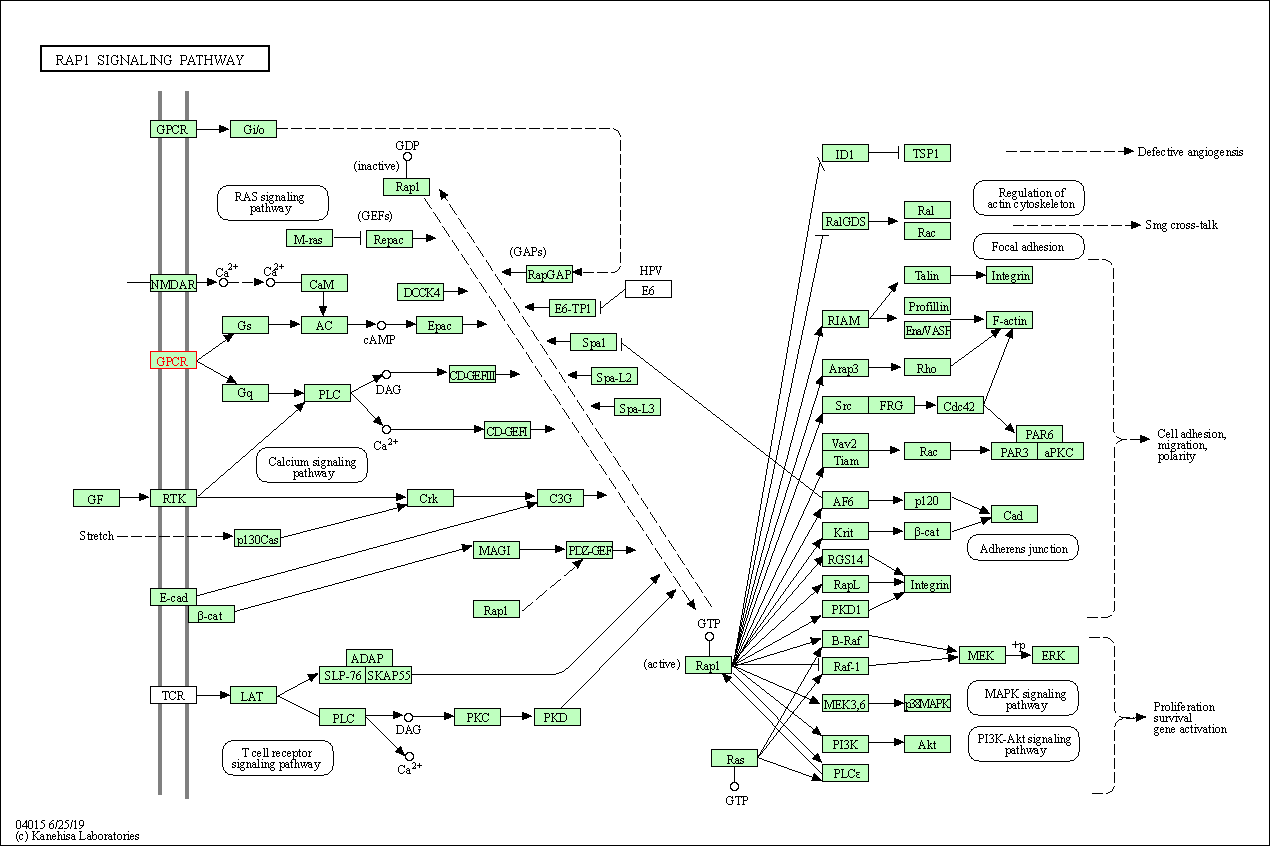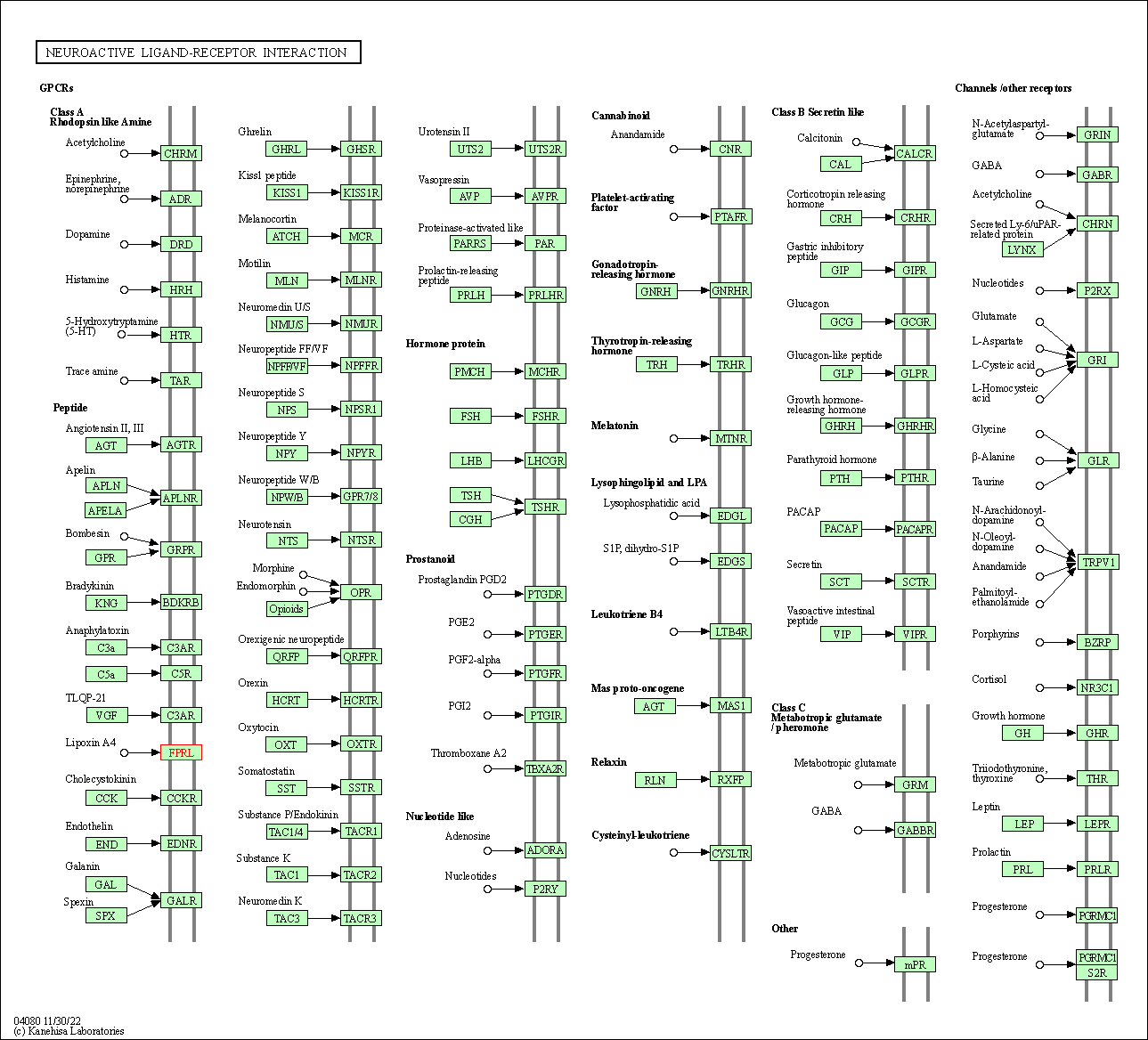Target Information
| Target General Information | Top | |||||
|---|---|---|---|---|---|---|
| Target ID |
T87831
(Former ID: TTDR00011)
|
|||||
| Target Name |
N-formyl peptide receptor (FPR1)
|
|||||
| Synonyms |
N-formylpeptide chemoattractant receptor; FPR1; FPR
Click to Show/Hide
|
|||||
| Gene Name |
FPR1
|
|||||
| Target Type |
Clinical trial target
|
[1] | ||||
| Disease | [+] 1 Target-related Diseases | + | ||||
| 1 | Peptic ulcer [ICD-11: DA61] | |||||
| Function |
High affinity receptor for N-formyl-methionyl peptides (fMLP), which are powerful neutrophil chemotactic factors (PubMed:2161213, PubMed:2176894, PubMed:10514456, PubMed:15153520). Binding of fMLP to the receptor stimulates intracellular calcium mobilization and superoxide anion release (PubMed:2161213, PubMed:1712023, PubMed:15153520). This response is mediated via a G-protein that activates a phosphatidylinositol- calcium second messenger system(PubMed:1712023, PubMed:10514456).
Click to Show/Hide
|
|||||
| BioChemical Class |
GPCR rhodopsin
|
|||||
| UniProt ID | ||||||
| Sequence |
METNSSLPTNISGGTPAVSAGYLFLDIITYLVFAVTFVLGVLGNGLVIWVAGFRMTHTVT
TISYLNLAVADFCFTSTLPFFMVRKAMGGHWPFGWFLCKFVFTIVDINLFGSVFLIALIA LDRCVCVLHPVWTQNHRTVSLAKKVIIGPWVMALLLTLPVIIRVTTVPGKTGTVACTFNF SPWTNDPKERINVAVAMLTVRGIIRFIIGFSAPMSIVAVSYGLIATKIHKQGLIKSSRPL RVLSFVAAAFFLCWSPYQVVALIATVRIRELLQGMYKEIGIAVDVTSALAFFNSCLNPML YVFMGQDFRERLIHALPASLERALTEDSTQTSDTATNSTLPSAEVELQAK Click to Show/Hide
|
|||||
| 3D Structure | Click to Show 3D Structure of This Target | AlphaFold | ||||
| HIT2.0 ID | T71XEF | |||||
| Drugs and Modes of Action | Top | |||||
|---|---|---|---|---|---|---|
| Clinical Trial Drug(s) | [+] 1 Clinical Trial Drugs | + | ||||
| 1 | Rebamipide | Drug Info | Phase 3 | Peptic ulcer | [2], [3] | |
| Mode of Action | [+] 2 Modes of Action | + | ||||
| Antagonist | [+] 6 Antagonist drugs | + | ||||
| 1 | Rebamipide | Drug Info | [1] | |||
| 2 | 3570-0208 | Drug Info | [4] | |||
| 3 | BVT173187 | Drug Info | [8] | |||
| 4 | diamide 7 | Drug Info | [10] | |||
| 5 | group E 1682-2106 | Drug Info | [12] | |||
| 6 | methionine benzimidazole 6 | Drug Info | [10] | |||
| Agonist | [+] 7 Agonist drugs | + | ||||
| 1 | AG-09/1 | Drug Info | [5] | |||
| 2 | AG-11/03 | Drug Info | [6] | |||
| 3 | AG-14 | Drug Info | [7] | |||
| 4 | CGEN-855 | Drug Info | [9] | |||
| 5 | fMet-Leu-Phe | Drug Info | [11] | |||
| 6 | PMID22607879CR-(-)-5f | Drug Info | [13] | |||
| 7 | pyrazolone, 1 | Drug Info | [14] | |||
| Cell-based Target Expression Variations | Top | |||||
|---|---|---|---|---|---|---|
| Cell-based Target Expression Variations | ||||||
| Drug Binding Sites of Target | Top | |||||
|---|---|---|---|---|---|---|
| Ligand Name: Cholesterol | Ligand Info | |||||
| Structure Description | The structure of Formyl Peptide Receptor 1 in complex with Gi and peptide agonist fMIFL | PDB:7VFX | ||||
| Method | Electron microscopy | Resolution | 2.80 Å | Mutation | No | [15] |
| PDB Sequence |
YLFLDIITYL
31 VFAVTFVLGV41 LGNGLVIWVA51 GFRMTHTVTT61 ISYLNLAVAD71 FCFTSTLPFF 81 MVRKAMGGHW91 PFGWFLCKFV101 FTIVDINLFG111 SVFLIALIAL121 DRCVCVLHPV 131 WTQNHRTVSL141 AKKVIIGPWV151 MALLLTLPVI161 IRVTTVPGKT171 GTVACTFNFS 181 PWTNDPKERI191 NVAVAMLTVR201 GIIRFIIGFS211 APMSIVAVSY221 GLIATKIHKQ 231 GLIKSSRPLR241 VLSFVAAAFF251 LCWSPYQVVA261 LIATVRIREL271 LQGMYKEIGI 281 AVDVTSALAF291 FNSCLNPMLY301 VFMGQDFRER311 LIHAL
|
|||||
|
|
ILE48
4.273
GLY52
3.607
PHE53
3.980
HIS57
3.562
ILE62
3.773
LEU65
3.657
ASN66
3.535
VAL69
3.655
PHE72
4.044
CYS73
3.809
SER76
4.083
ILE104
4.052
ILE107
4.106
ASN108
4.739
PHE114
3.830
ALA117
3.885
|
|||||
| Click to View More Binding Site Information of This Target and Ligand Pair | ||||||
| Ligand Name: N-formylmethionine | Ligand Info | |||||
| Structure Description | The structure of Formyl Peptide Receptor 1 in complex with Gi and peptide agonist fMIFL | PDB:7VFX | ||||
| Method | Electron microscopy | Resolution | 2.80 Å | Mutation | No | [15] |
| PDB Sequence |
YLFLDIITYL
31 VFAVTFVLGV41 LGNGLVIWVA51 GFRMTHTVTT61 ISYLNLAVAD71 FCFTSTLPFF 81 MVRKAMGGHW91 PFGWFLCKFV101 FTIVDINLFG111 SVFLIALIAL121 DRCVCVLHPV 131 WTQNHRTVSL141 AKKVIIGPWV151 MALLLTLPVI161 IRVTTVPGKT171 GTVACTFNFS 181 PWTNDPKERI191 NVAVAMLTVR201 GIIRFIIGFS211 APMSIVAVSY221 GLIATKIHKQ 231 GLIKSSRPLR241 VLSFVAAAFF251 LCWSPYQVVA261 LIATVRIREL271 LQGMYKEIGI 281 AVDVTSALAF291 FNSCLNPMLY301 VFMGQDFRER311 LIHAL
|
|||||
|
|
||||||
| Click to View More Binding Site Information of This Target and Ligand Pair | ||||||
| Click to View More Binding Site Information of This Target with Different Ligands | ||||||
| Different Human System Profiles of Target | Top |
|---|---|
|
Human Similarity Proteins
of target is determined by comparing the sequence similarity of all human proteins with the target based on BLAST. The similarity proteins for a target are defined as the proteins with E-value < 0.005 and outside the protein families of the target.
A target that has fewer human similarity proteins outside its family is commonly regarded to possess a greater capacity to avoid undesired interactions and thus increase the possibility of finding successful drugs
(Brief Bioinform, 21: 649-662, 2020).
Human Pathway Affiliation
of target is determined by the life-essential pathways provided on KEGG database. The target-affiliated pathways were defined based on the following two criteria (a) the pathways of the studied target should be life-essential for both healthy individuals and patients, and (b) the studied target should occupy an upstream position in the pathways and therefore had the ability to regulate biological function.
Targets involved in a fewer pathways have greater likelihood to be successfully developed, while those associated with more human pathways increase the chance of undesirable interferences with other human processes
(Pharmacol Rev, 58: 259-279, 2006).
Biological Network Descriptors
of target is determined based on a human protein-protein interactions (PPI) network consisting of 9,309 proteins and 52,713 PPIs, which were with a high confidence score of ≥ 0.95 collected from STRING database.
The network properties of targets based on protein-protein interactions (PPIs) have been widely adopted for the assessment of target’s druggability. Proteins with high node degree tend to have a high impact on network function through multiple interactions, while proteins with high betweenness centrality are regarded to be central for communication in interaction networks and regulate the flow of signaling information
(Front Pharmacol, 9, 1245, 2018;
Curr Opin Struct Biol. 44:134-142, 2017).
Human Similarity Proteins
Human Pathway Affiliation
Biological Network Descriptors
|
|
| KEGG Pathway | Pathway ID | Affiliated Target | Pathway Map |
|---|---|---|---|
| Rap1 signaling pathway | hsa04015 | Affiliated Target |

|
| Class: Environmental Information Processing => Signal transduction | Pathway Hierarchy | ||
| Neuroactive ligand-receptor interaction | hsa04080 | Affiliated Target |

|
| Class: Environmental Information Processing => Signaling molecules and interaction | Pathway Hierarchy | ||
| Neutrophil extracellular trap formation | hsa04613 | Affiliated Target |

|
| Class: Organismal Systems => Immune system | Pathway Hierarchy | ||
| Degree | 5 | Degree centrality | 5.37E-04 | Betweenness centrality | 4.13E-04 |
|---|---|---|---|---|---|
| Closeness centrality | 2.08E-01 | Radiality | 1.36E+01 | Clustering coefficient | 3.00E-01 |
| Neighborhood connectivity | 1.48E+01 | Topological coefficient | 2.31E-01 | Eccentricity | 12 |
| Download | Click to Download the Full PPI Network of This Target | ||||
| Chemical Structure based Activity Landscape of Target | Top |
|---|---|
| Drug Property Profile of Target | Top | |
|---|---|---|
| (1) Molecular Weight (mw) based Drug Clustering | (2) Octanol/Water Partition Coefficient (xlogp) based Drug Clustering | |
|
|
||
| (3) Hydrogen Bond Donor Count (hbonddonor) based Drug Clustering | (4) Hydrogen Bond Acceptor Count (hbondacc) based Drug Clustering | |
|
|
||
| (5) Rotatable Bond Count (rotbonds) based Drug Clustering | (6) Topological Polar Surface Area (polararea) based Drug Clustering | |
|
|
||
| "RO5" indicates the cutoff set by lipinski's rule of five; "D123AB" colored in GREEN denotes the no violation of any cutoff in lipinski's rule of five; "D123AB" colored in PURPLE refers to the violation of only one cutoff in lipinski's rule of five; "D123AB" colored in BLACK represents the violation of more than one cutoffs in lipinski's rule of five | ||
| Target Poor or Non Binders | Top | |||||
|---|---|---|---|---|---|---|
| Target Poor or Non Binders | ||||||
| Target Affiliated Biological Pathways | Top | |||||
|---|---|---|---|---|---|---|
| KEGG Pathway | [+] 3 KEGG Pathways | + | ||||
| 1 | Rap1 signaling pathway | |||||
| 2 | Neuroactive ligand-receptor interaction | |||||
| 3 | Staphylococcus aureus infection | |||||
| NetPath Pathway | [+] 1 NetPath Pathways | + | ||||
| 1 | Leptin Signaling Pathway | |||||
| Panther Pathway | [+] 1 Panther Pathways | + | ||||
| 1 | Inflammation mediated by chemokine and cytokine signaling pathway | |||||
| PID Pathway | [+] 1 PID Pathways | + | ||||
| 1 | Urokinase-type plasminogen activator (uPA) and uPAR-mediated signaling | |||||
| Reactome | [+] 1 Reactome Pathways | + | ||||
| 1 | G alpha (i) signalling events | |||||
| WikiPathways | [+] 5 WikiPathways | + | ||||
| 1 | GPCRs, Class A Rhodopsin-like | |||||
| 2 | Human Complement System | |||||
| 3 | Peptide GPCRs | |||||
| 4 | GPCR ligand binding | |||||
| 5 | GPCR downstream signaling | |||||
| Target-Related Models and Studies | Top | |||||
|---|---|---|---|---|---|---|
| Target Validation | ||||||
| References | Top | |||||
|---|---|---|---|---|---|---|
| REF 1 | Rebamipide suppresses formyl-methionyl-leucyl-phenylalanine (fMLP)-induced superoxide production by inhibiting fMLP-receptor binding in human neutrophils. J Pharmacol Exp Ther. 2001 Apr;297(1):388-94. | |||||
| REF 2 | URL: http://www.guidetopharmacology.org Nucleic Acids Res. 2015 Oct 12. pii: gkv1037. The IUPHAR/BPS Guide to PHARMACOLOGY in 2016: towards curated quantitative interactions between 1300 protein targets and 6000 ligands. (Ligand id: 871). | |||||
| REF 3 | The roles of prostaglandin E receptor subtypes in the cytoprotective action of prostaglandin E2 in rat stomach. Aliment Pharmacol Ther. 2000 Apr;14 Suppl 1:116-24. | |||||
| REF 4 | Discovery of selective probes and antagonists for G-protein-coupled receptors FPR/FPRL1 and GPR30. Curr Top Med Chem. 2009;9(13):1227-36. | |||||
| REF 5 | Identification of novel small-molecule agonists for human formyl peptide receptors and pharmacophore models of their recognition. Mol Pharmacol. 2010 Feb;77(2):159-70. | |||||
| REF 6 | Molecular docking of 2-(benzimidazol-2-ylthio)-N-phenylacetamide-derived small-molecule agonists of human formyl peptide receptor 1. J Mol Model. 2012 Jun;18(6):2831-43. | |||||
| REF 7 | High-throughput screening for small-molecule activators of neutrophils: identification of novel N-formyl peptide receptor agonists. Mol Pharmacol. 2007 Apr;71(4):1061-74. | |||||
| REF 8 | A non-peptide receptor inhibitor with selectivity for one of the neutrophil formyl peptide receptors, FPR 1. Biochem Pharmacol. 2012 Jun 15;83(12):1655-62. | |||||
| REF 9 | URL: http://www.guidetopharmacology.org Nucleic Acids Res. 2015 Oct 12. pii: gkv1037. The IUPHAR/BPS Guide to PHARMACOLOGY in 2016: towards curated quantitative interactions between 1300 protein targets and 6000 ligands. (Target id: 222). | |||||
| REF 10 | Discovery of small molecule human FPR1 receptor antagonists. Bioorg Med Chem Lett. 2011 May 15;21(10):2991-7. | |||||
| REF 11 | Further studies on the structural requirements for synthetic peptide chemoattractants. Biochemistry. 1980 May 27;19(11):2404-10. | |||||
| REF 12 | Integration of virtual screening with high-throughput flow cytometry to identify novel small molecule formylpeptide receptor antagonists. Mol Pharmacol. 2005 Nov;68(5):1301-10. | |||||
| REF 13 | Synthesis, enantioresolution, and activity profile of chiral 6-methyl-2,4-disubstituted pyridazin-3(2H)-ones as potent N-formyl peptide receptor agonists. Bioorg Med Chem. 2012 Jun 15;20(12):3781-92. | |||||
| REF 14 | Functional characterization of three mouse formyl peptide receptors. Mol Pharmacol. 2013 Feb;83(2):389-98. | |||||
| REF 15 | Structural basis for recognition of N-formyl peptides as pathogen-associated molecular patterns. Nat Commun. 2022 Sep 5;13(1):5232. | |||||
If You Find Any Error in Data or Bug in Web Service, Please Kindly Report It to Dr. Zhou and Dr. Zhang.

